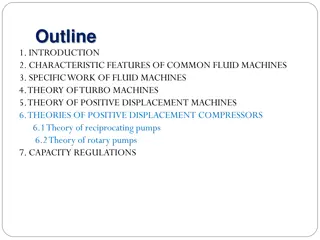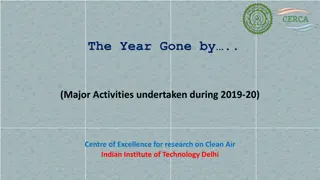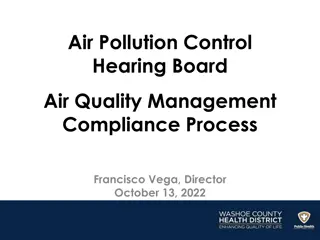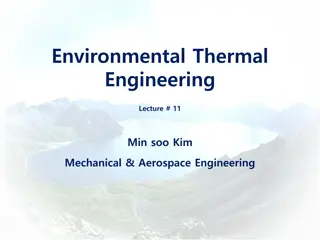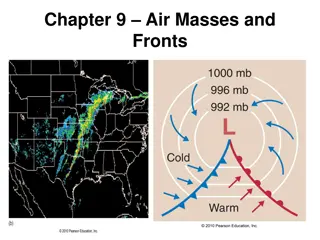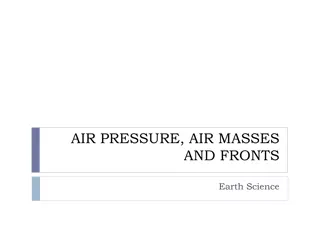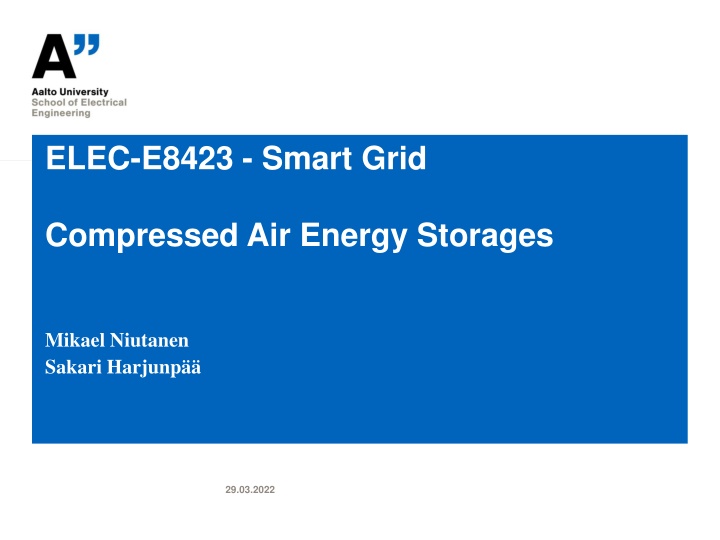
Smart Grid Compressed Air Energy Storage: Key Technical Insights
Dive into the world of Compressed Air Energy Storage (CAES) to understand how it stores energy through air compression, with a focus on efficiency, economic factors, and temperature control. Discover the working principles, technical specifications, storage capacity calculations, and notable CAES plants worldwide. Explore the current utilization of this innovative energy storage technology and its comparison to other grid-connected storage methods like Pumped-Storage Hydropower.
Download Presentation

Please find below an Image/Link to download the presentation.
The content on the website is provided AS IS for your information and personal use only. It may not be sold, licensed, or shared on other websites without obtaining consent from the author. If you encounter any issues during the download, it is possible that the publisher has removed the file from their server.
You are allowed to download the files provided on this website for personal or commercial use, subject to the condition that they are used lawfully. All files are the property of their respective owners.
The content on the website is provided AS IS for your information and personal use only. It may not be sold, licensed, or shared on other websites without obtaining consent from the author.
E N D
Presentation Transcript
ELEC-E8423 - Smart Grid Compressed Air Energy Storages Mikael Niutanen Sakari Harjunp 29.03.2022
Introduction Compressed Air Energy Storage (CAES) is a way to store mechanical energy by compressing air and releasing the pressure in later time. Key points about CAES: - Often used to store excess power in utility scale to underground chambers - When compressing air there is also a lot of heat generated making heat capture important for better efficiency - Can also be used in smaller scales with pressure tank. 07.02.2018 Page 2
Working principles 07.02.2018 Page 3
Technical and economical information - Efficiency: 42%-55%, depends on waste heat utilization - Volumetric energy density: 4 kWh/m3 - Lifetime: >30 years - Power Investment Cost: 400-800 $/kW vs. Li-ion > 1200 $/kW - Energy Investment Cost: 20-50 $/kWh (Alabama) vs. Li-ion > 500 $/kWh 07.02.2018 Page 4
Temperature control - The ideal gas law (pV = nRT) tells us about relation between temperature and pressure - Preheating and cooling allow better efficiency - Increased ambient temperature lowers the density of the inlet air -> reduces massflow 07.02.2018 Page 5
Storage capacity: For isothermal storage: ?? ????? ?? ?? ?? ?? ? = ? ?? = ?? = ?????? = ?????? ? ?? ?? (Note: ?? ??=?? ??) A typical CAES system has a pressure of around 70 bar (7 MPa). Let s imagine a storage V = 300 m3 ?? ?? ?.? ??? ?.? ??? + ?? ????= ? ??? ????? ?? ? = ?????? + ? ??? ?.? ??? ????? ???? ?? ???? ??? 07.02.2018 Page 6
Current utilization Notable plants - 1978 first utility-scale compressed air energy storage was built in Germany. Capacity of 580 MWh energy. - 1991 Alabama. Capacity of 2860 MWh energy. - 2012 Texas. Capacity of 300 MWh - 2019 Ontario. Capacity of 10MWh. - Many smaller plants and many in the planning phase 07.02.2018 Page 7
Current utilization - Second biggest energy grid connected storage method (PUMPED-STORAGE HYDROPOWER) 07.02.2018 Page 8
Current utilization (Rest Of The World) 07.02.2018 Page 9
Limitations and conclusions - Role of heat control is critical for energy efficiency - Limited availability of suitable salt caverns in Europe - Problem with scalability - CAES is good solution for energy storage where pumped hydro is not available - In the future CAES might have even more prevalent role in the energy system 07.02.2018 Page 10
Sources -Budt, M., Wolf, D., Span, R., & Yan, J. (2016). A review on compressed air energy storage: Basic principles, past milestones and recent developments. Applied Energy, 170, 250 268. https://doi.org/10.1016/j.apenergy.2016.02.108 -Energy Storage Market Report 2020 - Department of Energy. (2020). Retrieved March 29, 2022, from https://www.energy.gov/sites/prod/files/2020/12/f81/Energy%20Storage%20Market%20Report%202020_0.pdf -Technology Roadmap: Energy Storage - Researchgate. (2014) Retrieved March 29, 2022, from https://www.researchgate.net/publication/261848307_Technology_Roadmap_Energy_storage -Kushnir, R., Ullmann, A., & Dayan, A. (2012). Thermodynamic models for the temperature and pressure variations within adiabatic caverns of compressed air energy storage plants. Journal of Energy Resources Technology, 134(2). https://doi.org/10.1115/1.4005659 -An introduction to the compressed air energy storage. (2014). Computational Models for CO2 Geo-Sequestration & Compressed Air Energy Storage, 463 474. https://doi.org/10.1201/b16790-23 07.02.2018 Page 11







